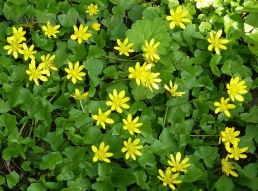The end of January is nigh and Mistress Agnes’ thoughts turn to her garden in springtime. The Pilewort will soon be showing its yellow blooms. ’Tis a beauteous ground covering plant, giving much cheer in the dark days of February. Some do know it as Lesser Celandine (ranunculus ficaria), though it bears little resemblance to its greater brother. ‘Wort’ be an old English word for ‘plant ’ or ‘herb’, so to be termed a wort means that the plant hath been here many hundreds of years, even in Mistress Agnes’ time.
 For what might she use such a wonderous plant? Well, if I do tell you that the clue is in the first part of the name mahap some can guess. Mistress Agnes will be bruising the plant, mixing it with a little animal fat and offering it as an ointment for treatment of the affected part. Safe to say she will not be volunteering to assist with the application. The Doctrine of Signatures, upon which Mistress Agnes doth base many of her cures, suggests that God hath given folk a clue as to how a plant might be used by its appearance. If you should dig up the Pilewort, do observe its roots good gentles, for they doth resemble the haemorrhoids.
For what might she use such a wonderous plant? Well, if I do tell you that the clue is in the first part of the name mahap some can guess. Mistress Agnes will be bruising the plant, mixing it with a little animal fat and offering it as an ointment for treatment of the affected part. Safe to say she will not be volunteering to assist with the application. The Doctrine of Signatures, upon which Mistress Agnes doth base many of her cures, suggests that God hath given folk a clue as to how a plant might be used by its appearance. If you should dig up the Pilewort, do observe its roots good gentles, for they doth resemble the haemorrhoids.
Swords and Spindles offer presentations on the history of medicine, gardening history and the medicinal use of herbs in past times
